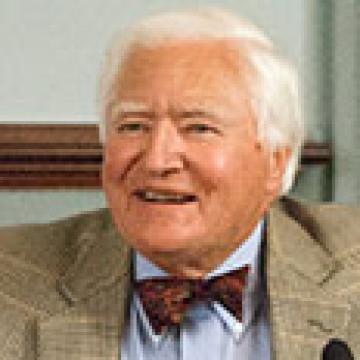Millard Fillmore: Life in Brief
Born into desperate poverty at the dawn of the nineteenth century, Millard Fillmore climbed to the highest office in the land—and inherited a nation breaking into fragments over the question of slavery. Despite his best efforts, the lines of the future battles of the Civil War were drawn, and Fillmore found himself rejected by his own dying party and denied renomination. After almost a quarter of a century out of the White House, he died in New York state in 1874.
Fillmore, the second of eight children, was born into an impoverished family on January 7, 1800. His family's small farm in upstate Cayuga County, New York, could not support them, and Fillmore's father apprenticed his son to a cloth maker, a brutal apprenticeship that stopped just short of slavery. Fillmore taught himself to read, stealing books on occasion, and finally managed to borrow thirty dollars and pay his obligation to the cloth maker. Free, he walked one hundred miles to get back home to his family.
He was obsessed with educating himself. He pored over every book he could get his hands on and attended school in a nearby town for six months. His teacher, Abigail Powers, encouraged and helped him. She would prove to be the most influential person in his life. She was only nineteen—not even two years older than her pupil. After Fillmore received a clerkship with a local judge, he began to court Abigail Powers. The couple married in 1826.
Anti-Jackson Politics
As a young lawyer, Fillmore was approached by a fledgling political party and asked to run for the New York State Assembly. In 1829, he began the first of three terms in the assembly, where he sponsored a substantial amount of legislation. In 1832, Millard Fillmore was elected to the U.S. House of Representatives.
At that time, Andrew Jackson was President. Jackson's repeated clashes with Congress and his ambitious attempts to expand presidential power united several parties against him. Fillmore's own Anti-Masonic Party merged with the Whigs, which represented the older, more entrenched power structure and opposed everything that Jackson and the Democrats represented. In 1843, at the end of four terms in Congress, which were interrupted by one defeat, Fillmore resigned from the legislature. After unsuccessfully lobbying for the vice presidential nomination on the Whig ticket with Henry Clay and losing an election for governor of New York, both in 1844, Fillmore was elected New York State comptroller, or chief financial officer, in 1847. He won this election by such a wide margin that he was immediately considered a prospect for national office.
The Whigs selected the military hero General Zachary Taylor as their presidential nominee for the election of 1848. The nomination of a slave owner who held property in Louisiana, Kentucky, and Mississippi infuriated abolitionist Whigs from the North. The party decided to balance the ticket by putting a Northerner in the vice presidential slot. Hence, Fillmore was chosen. The Taylor-Fillmore ticket won a bitterly fought election over the Democratic ticket led by Michigan senator Lewis Cass. Taylor and Fillmore were an odd match—the products of very different backgrounds and educations and far apart on the issues of the day. The two men did not meet until after the election and did not hit it off when they did. In a short time, Fillmore found himself excluded from the councils of power, relegated to his role as president of the Senate.
Slavery and the Compromise of 1850
The critical issue facing President Taylor was slavery. Henry Clay had crafted a series of proposals into an omnibus bill that became known as the Compromise of 1850, a patchwork of legislation that would admit California as a new free state; organize New Mexico and Utah, the remainder of the Mexican Cession, as territories on the basis of popular sovereignty; and readjust the disputed boundary between Texas and New Mexico. The compromise also established a fugitive slave law that guaranteed that runaway slaves apprehended anywhere in the United States would be returned to their owners. Taylor refused to take a stand, and the compromise bill was stalled in endless debates in the Senate by mid-1850. But then the unthinkable happened: the President died, possibly of cholera.
As President, Fillmore strongly supported the compromise. Allying himself with the Democratic Senator Stephen Douglas and appointing the procompromise Whig Daniel Webster as his secretary of state, Fillmore engineered its passage. By forcing these issues, Fillmore believed he had helped to safeguard the Union, but it soon became clear that the compromise, rather than satisfying anyone, gave everyone something to hate. Under the strains of the failed agreement, the Whig Party began to come apart at the seams.
On the international stage, Fillmore dispatched Commodore Perry to "open" Japan to Western trade and worked to keep the Hawaiian Islands out of European hands. He refused to back an invasion of Cuba by a group of Southern adventurers who wanted to expand the South into a slave-based Caribbean empire. This "filibustering" expedition failed, and Fillmore took the blame from Southerners. At the same time, he offended Northerners by enforcing the Fugitive Slave Law in their region. Weary and dispirited, he tried to decline to run again but was prevailed upon to allow his name to be put forward—only to lose the nomination to General Winfield Scott. Shortly thereafter, his beloved Abigail died, followed by his twenty-two-year-old daughter Mary.
In 1856, he ran for election as the presidential candidate of the Whig-American Party, a fusion of the remaining Whigs and the anti-immigrant American (nicknamed "Know-Nothing") Party. He won the Electoral College votes of Maryland and 21 percent of the popular vote. But the newly organized Republican Party, even in defeat, eclipsed Fillmore and the Whigs, winning 33 percent of the vote, and Fillmore's poor performance marked the end of his party. Millard Fillmore died of a stroke in March of 1874.
